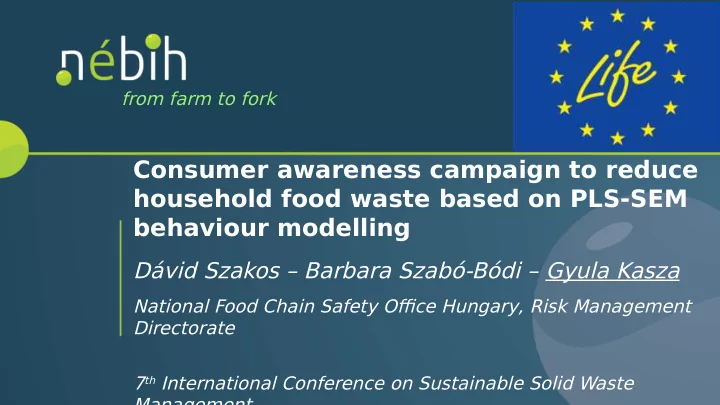

from farm to fork Consumer awareness campaign to reduce household food waste based on PLS-SEM behaviour modelling Dávid Szakos – Barbara Szabó-Bódi – Gyula Kasza National Food Chain Safety Offjce Hungary, Risk Management Directorate 7 th International Conference on Sustainable Solid Waste Management
European situation in a nutshell EU estimation: 46.5 million 88 million tons tons 5,00% Households 11,00% Processing 12,00% Catering 53,00% Production 19,00% Average: Retail 92 kg/capita/year FUSIONS, 2016
National Food Chain Safety Offjce - Central (national level) authority founded in 1888 - Food chain control from soil to retailers and restaurants - Risk communication (2000 interviews and press releases annually) - Well known, popular and credible organization amongst Hungarians (EFSA, 2018)
every complex problem there is an swer t is clear , simple , wrong . encken
T ypical simple, clear and wrong answers: - Why not to give leftovers from event catering to poor people? - Why not to give expired food to the poor? - Why not to give all restaurant leftovers to animals as feed? - Why destroying all those fjne food stufgs that were confjscated by the authority instead of charity? Further details: Kasza, Gy., Szabó-Bódi, B., Lakner , Z., & Izsó, T . (2019). Balancing the desire to decrease food waste with requirements of food safety. Trends in Food Science & Technology 84: 74-76.
ter years of answering press and NGO inquiries and suggestio ne-by-one, have decided to start a public campaign and vite all interested partners as stakeholders:
PROJECT REFERENCE LIFE15 GIE/HU/001048 DURATION 07/07/2016 - 30/06/20 20 TOTAL BUDGET 964,468.00 € EU CONTRIBUTION 578,680.00 € ACTIVITIES KEYWORDS Awareness raising Environmental education communication campaign Public awareness campaign School programme Waste reduction Working groups’ good practices Scientifjc elements
Consumer studies Scientifjc results to the communication campaign 1. Measurement of households’ food waste* 2. Attitude reasons behind the routine – PLS-SEM modelling based on survey results *Further details: Szabó-Bódi B., Szakos D., & Kasza Gy. (2018). Assessment of Household Food Waste in Hungary. British Food Journal 120 (3), 625-638.
Methodology – Sample collection - Quantitative consumer survey (November- December 2016) - N=1002 - Sample is representative to the total adult population of Hungary (by latest census data) Age Sex Geographical distribution
Theoretical background Theory of multidimensional attitudes (Allport, 1935) 1. Cognitive – thinking 2. Afgective – feeling 3. Conative – doing
Methodology Background of PLS-SEM modelling - Partial least squares structural equation modelling (variance based) - Second generation data analysis - T wo operations simultaneously: 1. Factor analysis (new latent variables) 2. Regression analysis (relationship between new latent variables) - Handles ordinal scales and does not require normal distribution - Softwares: IBM SPSS Statistics 22.0, SmartPLS
Results
Normative model
Routine (=conative component) is the most prominent!
Efgect of demographical factors (p<0.05) Mean Income Mean Educatio Age Mean Residence Mean Region Mean n Under -0.268 Primary -0.186 Central 0.415 Low 0.055 Municipality 0.212 30 years school Hungary 30-39 0.372 Average -0.003 Vocation -0.051 Transdanubi -0.460 T own -0.043 years al school a High 40-59 school 0.261 Great Plain -0.045 High 0.315 -0.048 Capital city -0.130 years graduati and North on Higher Over 60 -0.553 educatio 0.094 years n
Explicative model
Conclusions - Normative model proved: prominent role of conative attitude component: school programme is important! - Explicative model: practical aspects of behaviour - Most infmuential socio-demographical factors: income, age, education, residence and region: targeting communication - PLS-SEM modelling is a great tool to design communication campaigns, as happened in the Wasteless campaign in Hungary
Thank you for your kind attention!
Recommend
More recommend